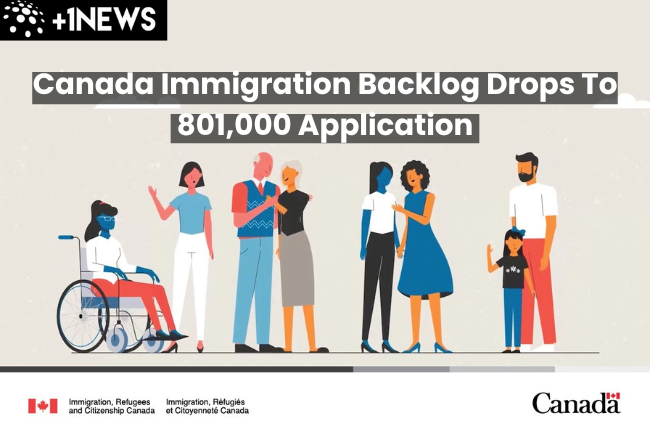As of July 25, 2023, Canada Immigration backlog has dropped slightly to 801,000. This data is the most recent report by Immigration, Refugees and Citizenship Canada (IRCC), updated on July 25, 2023, and is up-to-date as of June 30, 2023.
As of July 25, 2023, there were about 2.3 million immigration, citizenship, and visa applications from Canada being worked on. This information comes from the latest update from the IRCC.
Of the total 2,264,000 applications, 801,000 were in backlog and taking longer than the usual time set by the IRCC.
On the bright side, 1,462,700 applications were being processed within the normal time range of the IRCC. This is an increase of 34,700 from the last update.
The good news is that the backlog, or the number of applications taking too long, has decreased by 19,000 since last month.
Jump to:
Current Status of Canada Immigration Backlog
As of May 31, 2023, the following is the state of Canada immigration backlog:
- Total applications in all IRCC inventories: 2,264,000
- Applications within service standards: 1,462,700
- Applications in backlog (exceeding service standards): 801,000
| Application Type | Total Applications | Backlog | Applications Within Standards |
| Citizenship | 302,000 | 72,000 | 230,000 |
| Permanent Residence | 644,000 | 303,000 | 341,000 |
| Temporary Residence | 1,318,000 | 426,000 | 891,700 |
| Total | 2,264,000 | 801,000 | 1,462,700 |


Summary of Canada Immigration Backlog 2023
Looking back at Canada immigration backlog data over the past few months gives us a good sense of the trends and changes.
| Date | Backlog | Total Applications Under Processing |
| June 30, 2023 | 801,000 | 2,264,000 |
| May 31, 2023 | 820,000 | 2,248,000 |
| April 30, 2023 | 809,000 | 2,006,000 |
| March 31, 2023 | 896,300 | 2,017,700 |
| February 28, 2023 | 910,400 | 1,962,600 |
| January 31, 2023 | 974,600 | 1,944,500 |
From January to May 2023, there has been a reduction in the backlog from 974,600 to 801,000.
Canada Immigration Backlog Projections 2023
The IRCC data also includes backlog projections for various application types, providing a glimpse into the future. Here’s what we can anticipate:
- Federal High Skilled (Including Express Entry): Reduction to 20% by July 2023
- Express Entry Provincial Nominee Program: Reduction to 22% by July 2023
- Spouses, Partners, and Children Applications: Steady at 24% till August 2023
- Citizenship: Steady at 24% till July 2023
- Study Permit: Reduction to 15% by July 2023
- Work Permit: Reduction to 22% by July 2023
- Temporary Residence Visa (Visitor Visa): Reduction to 42% by July 2023
Backlog of Federal High-Skilled Applications
Backlog of Federal High-Skilled Applications
| Month | Backlog (Actual) | Backlog (Projected) |
| Jan 23 | 20% | 20% |
| Feb 23 | 20% | 20% |
| Mar 23 | 18% | 20% |
| Apr 23 | 17% | 20% |
| May 23 | 15% | 20% |
| Jun 23 | – | 20% |
| Jul 23 | – | 20% |
| Aug 23 | – | 20% |
| Sep 23 | – | 20% |
Backlog of Provincial Nominee Program (Express Entry) Applications
Backlog of Provincial Nominee Program (Express Entry) Applications
| Month | Backlog (Actual) | Backlog (Projected) |
| Jan 23 | 38% | 40% |
| Feb 23 | 32% | 39% |
| Mar 23 | 30% | 32% |
| Apr 23 | 28% | 30% |
| May 23 | 30% | 28% |
| Jun 23 | – | 24% |
| Jul 23 | – | 22% |
| Aug 23 | – | 21% |
| Sep 23 | – | 20% |
The Comprehensive Guide to Canada’s Provincial Nominee Programs (PNPs)
Backlog of Spouses, Partners and Children (except for Quebec) Applications
Backlog of Spouses, Partners and Children (except for Quebec) Applications
| Month | Backlog (Actual) | Backlog (Projected) |
| Jan 23 | 24% | 24% |
| Feb 23 | 23% | 24% |
| Mar 23 | 24% | 24% |
| Apr 23 | 23% | 24% |
| May 23 | 20% | 24% |
| Jun 23 | – | 24% |
| Jul 23 | – | 24% |
| Aug 23 | – | 24% |
| Sep 23 | – | 24% |
Backlog of Citizenship Grant Applications
Backlog of Citizenship Grant Applications
| Month | Backlog (Actual) | Backlog (Projected) |
| Jan 23 | 27% | 26% |
| Feb 23 | 26% | 25% |
| Mar 23 | 25% | 24% |
| Apr 23 | 25% | 24% |
| May 23 | 23% | 24% |
| Jun 23 | – | 24% |
| Jul 23 | – | 24% |
| Aug 23 | – | 26% |
| Sep 23 | – | 26% |
Backlog of Temporary Resident Visas (TRV)
Backlog of Temporary Resident Visas (TRV)
Approximately 19% of temporary resident visa (or visitor visa) applications in our inventories are from the Canada-Ukraine authorization for emergency travel.
| Month | Backlog (Actual) | Backlog (Projected) |
| Jan 23 | 68% | 68% |
| Feb 23 | 64% | 68% |
| Mar 23 | 61% | 65% |
| Apr 23 | 50% | 56% |
| May 23 | 45% | 42% |
| Jun 23 | – | 42% |
| Jul 23 | – | 42% |
| Aug 23 | – | 43% |
| Sep 23 | – | 36% |
Backlog of Study Permits
Backlog of Study Permits
| Month | Backlog (Actual) | Backlog (Projected) |
| Jan 23 | 35% | 36% |
| Feb 23 | 29% | 34% |
| Mar 23 | 23 % | 25% |
| Apr 23 | 18% | 22% |
| May 23 | 17% | 15% |
| Jun 23 | – | 15% |
| Jul 23 | – | 15% |
| Aug 23 | – | 19% |
| Sep 23 | – | 17% |
Study Permit for Canada: Your Step-by-Step Guide to Application and Requirements
Backlog of Work Permits
Backlog of Work Permits
Approximately 72% of work permits in our inventories are from the Canada-Ukraine authorization for emergency travel.
| Month | Backlog (Actual) | Backlog (Projected) |
| Jan 23 | 26% | 26% |
| Feb 23 | 23% | 28% |
| Mar 23 | 18 % | 28% |
| Apr 23 | 22% | 26% |
| May 23 | 27% | 24% |
| Jun 23 | – | 22% |
| Jul 23 | – | 22% |
| Aug 23 | – | 22% |
| Sep 23 | – | 20% |
Post-Graduation Work Permit (PGWP) in Canada: The Complete Guide for International Students
What is Canada Immigration Backlog?
In simple terms, Canada immigration backlog refers to immigration applications that have exceeded the standard processing times established by the IRCC. These applications differ from those being processed within the normal service standards, which are applications that fall within the stipulated time frame. Currently, the IRCC’s goal is to process 80% of all applications within their service standards.
Difference between Backlog vs. Service Standard:
Finally, it’s essential to distinguish between a backlog and applications within the service standard. If an application is being processed within the expected time frame (say 12 months), it’s considered ‘within service standard’ and not a backlog. However, if the processing time exceeds the set standard, it’s deemed to be part of the backlog.
The ultimate aim of the IRCC is to process 80% of applications within service standards.
Current IRCC Application Management:
IRCC manages over 1 million applications across its programs. In 2022, it finalized more than 5.2 million decisions, displaying its commitment to efficient processing.
Conclusion:
Canada’s dedication to building a strong immigration system acknowledges the significant contributions of newcomers. By working to reduce the backlog, IRCC is making immigration more accessible and inviting. This creates a diverse and thriving society, making Canada an attractive destination for those seeking new opportunities and a brighter future.
Frequently Asked Questions:
Q1. How does IRCC define backlog?
IRCC considers applications that exceed the standard processing time as part of the backlog.
Q2. What is the significance of reducing the backlog?
Reducing the backlog leads to faster and smoother processing of applications, making the immigration system more efficient and effective.














